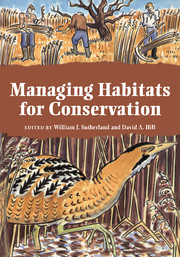Book contents
- Frontmatter
- Contents
- List of Contributors
- Acknowledgements
- 1 Introduction and principles of ecological management
- 2 Site management planning
- 3 Access
- 4 Coastal habitats
- 5 Rivers, canals and dykes
- 6 Waterbodies
- 7 Reedbeds, fens and acid bogs
- 8 Grasslands
- 9 Farmland
- 10 Lowland heathland
- 11 Upland moors and heaths
- 12 Woodland and scrub
- 13 Urban areas
- Some useful addresses
- Index of species by common names
- Subject index
5 - Rivers, canals and dykes
Published online by Cambridge University Press: 05 February 2015
- Frontmatter
- Contents
- List of Contributors
- Acknowledgements
- 1 Introduction and principles of ecological management
- 2 Site management planning
- 3 Access
- 4 Coastal habitats
- 5 Rivers, canals and dykes
- 6 Waterbodies
- 7 Reedbeds, fens and acid bogs
- 8 Grasslands
- 9 Farmland
- 10 Lowland heathland
- 11 Upland moors and heaths
- 12 Woodland and scrub
- 13 Urban areas
- Some useful addresses
- Index of species by common names
- Subject index
Summary
Introduction
Rivers, canals and dykes are probably the most accessible of all habitats to man due to their intricate, vein-like distribution throughout the land. They are also taken for granted, despite their historical and ecological interest.
The retreating glaciers of 12 000 years ago left a network of rivers which have played a major part in moulding the wildlife and landscape character of Britain. During the early settlements of man rivers were often obstacles to expanding territories; later this changed and they became the highways for population movements and trading. The deep and large rivers formed an arterial system of transportation for centuries until the end of the eighteenth century, when the first artificial canals were built to link the natural highways together. The industrial revolution was built on the traffic coursing through the waterways of Britain, a shared role between rivers and canals. Today it is a very different story, with navigation on rivers and canals being primarily by pleasure craft.
Although there are vast ecological differences between mountain rivers and lowland Systems, plant and animal communities of many lowland rivers, canals and dykes may have much in common. A few plants and animals are almost exclusively found in fast-flowing rivers (e.g. stoneflies such as Perla spp., mosses such as Hygrohypnum spp.), but the majority also occur on wave-washed rocky lake shores. Dykes and canals also have few species occurring in them exclusively; however, grazing marsh dykes are known to support some invertebrates which have been recorded from no other habitats.
- Type
- Chapter
- Information
- Managing Habitats for Conservation , pp. 84 - 120Publisher: Cambridge University PressPrint publication year: 1995
- 3
- Cited by



